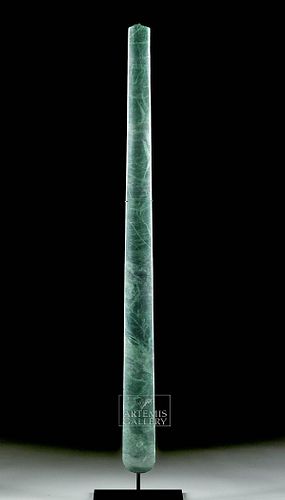Huge / Rare Olmec Jadeite Celt - 30"L
Lot 72
About Seller
Artemis Fine Arts
686 S Taylor Ave, Ste 106
Louisville, CO 80027
United States
Selling antiquities, ancient and ethnographic art online since 1993, Artemis Gallery specializes in Classical Antiquities (Egyptian, Greek, Roman, Near Eastern), Asian, Pre-Columbian, African / Tribal / Oceanographic art. Our extensive inventory includes pottery, stone, metal, wood, glass and textil...Read more
Categories
Estimate:
$9,500 - $14,250
Absentee vs Live bid
Two ways to bid:
- Leave a max absentee bid and the platform will bid on your behalf up to your maximum bid during the live auction.
- Bid live during the auction and your bids will be submitted real-time to the auctioneer.
Bid Increments
| Price | Bid Increment |
|---|---|
| $0 | $25 |
| $300 | $50 |
| $1,000 | $100 |
| $2,000 | $250 |
| $5,000 | $500 |
| $10,000 | $1,000 |
| $20,000 | $2,500 |
| $50,000 | $5,000 |
| $100,000 | $10,000 |
| $200,000 | $20,000 |
About Auction
By Artemis Fine Arts
Oct 21, 2021
Set Reminder
2021-10-21 10:00:00
2021-10-21 10:00:00
America/New_York
Bidsquare
Bidsquare : Fall Antiquities & Ethnographic Art Auction
https://www.bidsquare.com/auctions/artemis-gallery/fall-antiquities-ethnographic-art-auction-7725
Ancient art from Egypt, Greece, Italy and the Near East, as well as Asian, Fossils, Pre-Columbian, Native American, African / Tribal / Oceanic, Fine art, and much more! All categories, all price ranges... all legally acquired and guaranteed to be as described or your money back. Artemis Fine Arts info@artemisgallery.com
Ancient art from Egypt, Greece, Italy and the Near East, as well as Asian, Fossils, Pre-Columbian, Native American, African / Tribal / Oceanic, Fine art, and much more! All categories, all price ranges... all legally acquired and guaranteed to be as described or your money back. Artemis Fine Arts info@artemisgallery.com
- Lot Description
Pre-Columbian, Southern Mexico to Guatemala, Olmec, ca. 1150 to 550 BCE. An extraordinary celt both in size and presentation, hand-carved from a single contiguous piece of forest-green jadeite with densely-congregated natural veining of pale-green hues. The celt boasts convex faces that gently expand towards the wider head and an acutely-angled blade edge which courses around the peripheries before terminating at the rounded end of the thick handle. The celt is a tapered hand tool of a highly-stylized ritual form with an overall ovoid shape. Meticulously flaked and then sanded to a smooth, reflective sheen, this is a stunning piece of art, designed to resemble a common weapon but employed for a votive function. Examples of this size are incredibly scarce, but have been found in tombs standing together with jadeite anthropomorphic figures. Custom museum-quality display stand included. Size: 2.125" W x 29.4" H (5.4 cm x 74.7 cm); 31.6" H (80.3 cm) on included custom stand.
Olmec artisans used long distance trade routes to acquire greenstone like this from Eastern Guatemala, over three hundred miles from their homeland. All of this speaks to its immense value in society. Green stones like jadeite seem to have been associated with water, vegetation, and young corn, the staple food of Olmec life. Recent scholarship has linked the embrace of green serpentine by the Olmec to the importance of corn in the Olmec economy as greenstone along with quetzal plumes symbolized verdant maize, a most valuable staple, to the indigenous peoples. In fact, greenstone celts like this example symbolized ears of corn and were used as a form of currency by the Olmec (Karl A. Taube, Olmec Art at Dumbarton Oaks, 1996, p. 18). Based on burial practices, particularly the objects from important burials at La Venta in the present day Mexican state of Tabasco, we believe that green stone was reserved for high nobility, royalty, and the gods.
This item is an exemplar of ancient Mesoamerican sculpture, impressive for its technique, iconography, and well as the inherent beauty of ancient stone-working. A superb sculptural work from the Olmec, indeed the first Mesoamerican civilization that most regard as the forerunner of subsequent ancient American cultures such as the Maya and Aztecs!
A stylistically-similar example of a much smaller size hammered for EUR 21,250 ($24,287.37) at Christie's, Paris "A Quantum of History: The Progogine Collection" auction (sale 16282, April 9, 2018, lot 21): https://www.christies.com/lotfinder/sculptures-statues-figures/hache-votive-olmeque-preclassique-env-900-600-6131727-details.aspx?from=searchresults&intObjectID=6131727&sid=c31dfff8-7431-4b15-8ef6-e02521fe6985
Provenance: private Hawaii, USA collection; ex-Ian Arundel collection, The Curiosity Shop, Melrose, Los Angeles, California, USA, 1950s to 1960s
All items legal to buy/sell under U.S. Statute covering cultural patrimony Code 2600, CHAPTER 14, and are guaranteed to be as described or your money back.
A Certificate of Authenticity will accompany all winning bids.
PLEASE NOTE: Due to recent increases of shipments being seized by Australian & German customs (even for items with pre-UNESCO provenance), we will no longer ship most antiquities and ancient Chinese art to Australia & Germany. For categories of items that are acceptable to ship to Australia or Germany, please contact us directly or work with your local customs brokerage firm.
Display stands not described as included/custom in the item description are for photography purposes only and will not be included with the item upon shipping.
#143410Repaired from 4 large pieces with light restoration, resurfacing, and overpainting along break lines; light polishing done after repairs. Minor nicks to blade edge and both faces, with light abrasions. Smooth surface texture still present, and natural jadeite colors are still vivid. Old inventory label on verso.Condition
- Shipping Info
-
All shipping is handled in-house for your convenience. Your invoice from Artemis Gallery will include shipping calculation instructions. If in doubt, please inquire BEFORE bidding for estimated shipping costs for individual items.
-
- Buyer's Premium



 EUR
EUR CAD
CAD AUD
AUD GBP
GBP MXN
MXN HKD
HKD CNY
CNY MYR
MYR SEK
SEK SGD
SGD CHF
CHF THB
THB














